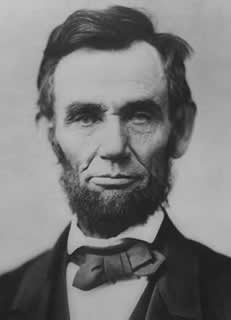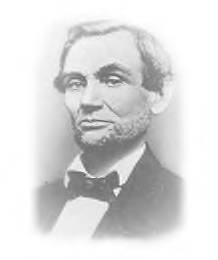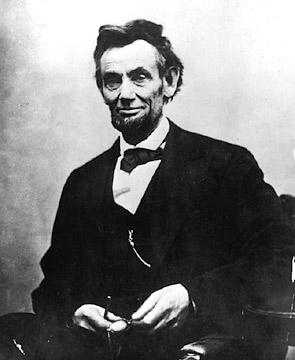|
An Overview of Abraham Lincoln's Life
|
| Abraham Lincoln was born Sunday, February 12, 1809, in a log cabin near Hodgenville, Kentucky. He was the son of Thomas and Nancy Hanks Lincoln, and he was named for his paternal grandfather. Thomas Lincoln was a carpenter and farmer. Both of Abraham's parents were members of a Baptist congregation which had separated from another church due to opposition to slavery.
When Abraham was seven, the family moved to southern Indiana. Abraham had gone to school briefly in Kentucky and did so again in Indiana. He attended school with his older sister, Sarah (his younger brother, Thomas, had died in infancy). In 1818 Nancy Hanks Lincoln died from milk sickness, a disease obtained from drinking the milk of cows which had grazed on poisonous white snakeroot. Thomas Lincoln remarried the next year, and Abraham loved his new stepmother, Sarah Bush Johnston Lincoln. She brought three children of her own into the household. Abraham attended school at irregular intervals. In all he spent less than 12 months going to school, and he didn't attend college at all.
As Abraham grew up, he loved to read and preferred learning to working in the fields. This led to a difficult relationship with his father who was just the opposite. Abraham was constantly borrowing books from the neighbors.
In 1828 Abraham's sister, who had married Aaron Grigsby in 1826, died during childbirth. Later in the year, Abraham made a flatboat trip to New Orleans. In 1830 the Lincolns moved west to Illinois.
The next year Lincoln made a second flatboat trip to New Orleans. Afterwards he moved to New Salem, Illinois, where he lived until 1837. While there he worked at several jobs including operating a store, surveying, and serving as postmaster. He impressed the residents with his character, wrestled the town bully, and earned the nickname "Honest Abe." Lincoln, who stood nearly 6-4 and weighed about 180 pounds, saw brief service in the Black Hawk War, and he made an unsuccessful run for the Illinois legislature in 1832. He ran again in 1834, 1836, 1838, and 1840, and he won all four times. Lincoln was a member of the Whig Party; he remained a Whig until 1856 when he became a Republican. Additionally, he studied law in his spare time and became a lawyer in 1836. Stories that Lincoln had a romance with a pretty girl named Ann Rutledge may well be true. Sadly, Ann died in 1835. |
|
|
In Springfield in 1839 Lincoln met Mary Todd. Three years later they were married and over the next 11 years had four children: Robert (1843-1926), Edward ("Eddie") 1846-1850, William ("Willie") 1850-1862, and Thomas ("Tad") 1853-1871. Lincoln became a successful attorney, and the family bought a home at the corner of Eighth and Jackson in 1844.
In 1846 Lincoln ran for the United States House of Representatives and won. While in Washington he became known for his opposition to the Mexican War and to slavery. He returned home after his term and resumed his law practice more seriously than ever. Early in 1851 Lincoln's father died.
Lincoln's declining interest in politics was renewed by the passage of the Kansas-Nebraska Act in 1854. He made an unsuccessful bid for the U.S. Senate but received some support for the Republican vice-presidential nomination in 1856. Also, in 1856 Lincoln gave his Lost Speech. He opposed the Dred Scott decision in 1857 and gave his famous "House Divided" Speech on June 16, 1858. Additionally, he engaged in a series of debates with Stephen A. Douglas in 1858. Lincoln was against the spread of slavery into the territories but was not an abolitionist. Douglas won the Senatorial race, but Lincoln gained national recognition. In 1860 he furthered his national reputation with a successful speech at the Cooper Institute in New York.
|
|
Although William Seward was the pre-convention favorite for the Republican presidential nomination in 1860, Lincoln won on the third ballot. With Hannibal Hamlin as his running mate, Lincoln was elected the 16th president on November 6, 1860, defeating Douglas, John Bell, and John C. Breckinridge.
In February of 1861 the Lincolns left by train for Washington, D.C. The president-elect was now wearing a beard at the suggestion of an 11-year-old girl. Lincoln was sworn in on March 4, 1861.
After Lincoln's election, many Southern states, fearing Republican control in the government, seceded from the Union. Lincoln faced the greatest internal crisis of any U.S. president. After the fall of Ft. Sumter, Lincoln raised an army and decided to fight to save the Union from falling apart. Initially, Lincoln anticipated a short conflict; he called for 75,000 volunteers to serve for three months. Despite enormous pressures, loss of life, battlefield setbacks, bickering among his Cabinet members, generals who weren't ready to fight, assassination threats, etc., Lincoln stuck with this pro-Union policy for four long years of Civil War. On January 1, 1863, the Emancipation Proclamation went into effect. This was Lincoln's declaration of freedom for all slaves in the areas of the Confederacy not under Union control. Also, on November 19, 1863, Lincoln gave his famous Gettysburg Address which dedicated the battlefield there to the soldiers who had perished. He called on the living to finish the task the dead soldiers had begun.
|
|
|
Lincoln's domestic policies included support for the Homestead Act. This act allowed poor people in the East to obtain land in the West. Also, Lincoln signed legislation entitled the National Banking Act which established a national currency and provided for the creation of a network of national banks. In addition, he signed tariff legislation that offered protection to American industry and signed a bill that chartered the first transcontinental railroad. Lincoln's foreign policy was geared toward preventing foreign intervention in the Civil War.
|
|
In 1864 Ulysses S. Grant was named general-in-chief of the armies of the United States. The South was slowly being worn down. Lincoln was reelected president with Andrew Johnson as his running mate. Lincoln defeated the Democrat George McClellan on November 8, 1864. On April 9, 1865, General Robert E. Lee surrendered to Grant. Two days later Lincoln addressed a crowd outside the White House. Among other things, he suggested he would support voting rights for certain blacks. This infuriated a racist and Southern sympathizer who was in the audience: the actor John Wilkes Booth who hated everything the president stood for.
On Good Friday, April 14, 1865, the Lincolns attended a play entitled Our American Cousin at Ford's Theatre. During the performance Booth arrived at the theater, entered the State Box from the rear, and shot the president in the back of his head at about 10:15 P.M. Lincoln was carried across the street to the Petersen House where he passed away the next day at 7:22 A.M. This was the first presidential assassination in American history, and the nation mourned its leader. His death was the result of the deep divisions and hatreds of the times. Lincoln's body was taken to Springfield by train, and he was buried in the Lincoln Tomb in Oak Ridge Cemetery on May 4, 1865. Because of the assassination, Reconstruction took place without Lincoln's guidance and leadership.
|
|
|
Abraham Lincoln is remembered for his vital role as the leader in preserving the Union during the Civil War and beginning the process that led to the end of slavery in the United States. He is also remembered for his character, his speeches and letters, and as a man of humble origins whose determination and perseverance led him to the nation's highest office.
CLICK HERE for a summary of Lincoln's major accomplishments as president.
CLICK HERE for more Lincoln information, personal data, and trivia.
CLICK HERE for a very brief summary of Lincoln's career as a lawyer.
CLICK HERE for a year-by-year outline
of Lincoln's life.
|
|
|
Source for pictures: the Library of Congress |
|
This is not a commercial website. None of the photographs and artwork exhibited herein are being sold by the webmaster. Some photographs and artwork are believed to be in the public domain. Any copyrighted photographs and artwork are used in the context of this website strictly for educational, research and historical purposes only, under the "Fair Use" provisions of the Copyright Act, (US CODE: Title 17,107. Limitations on exclusive rights: Fair Use Section 107). Anyone claiming copyright to any of the posted photographs or artwork please inform the webmaster of such and it will be duly noted or removed.
This page is part of the Abraham Lincoln Research Site. Questions, comments, corrections or suggestions can be sent to R. J. Norton, the creator and maintainer of this site. All text except reprinted articles was written by the webmaster, ©1996-2017. All rights reserved. It is unlawful to copy, reproduce or transmit in any form or by any means, electronic or hard copy, including reproducing on another web page, or in any information or retrieval system without the express written permission of the author. The website was born on December 29, 1996.
Web design by Andrew Patel.
|




